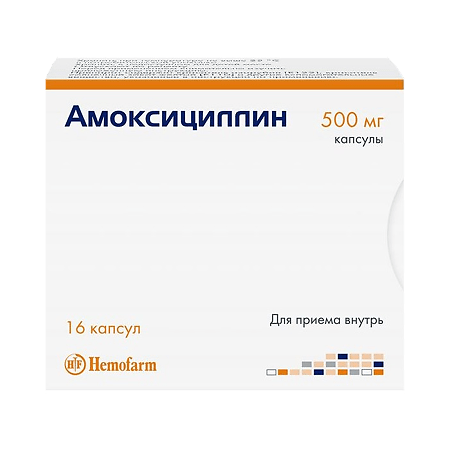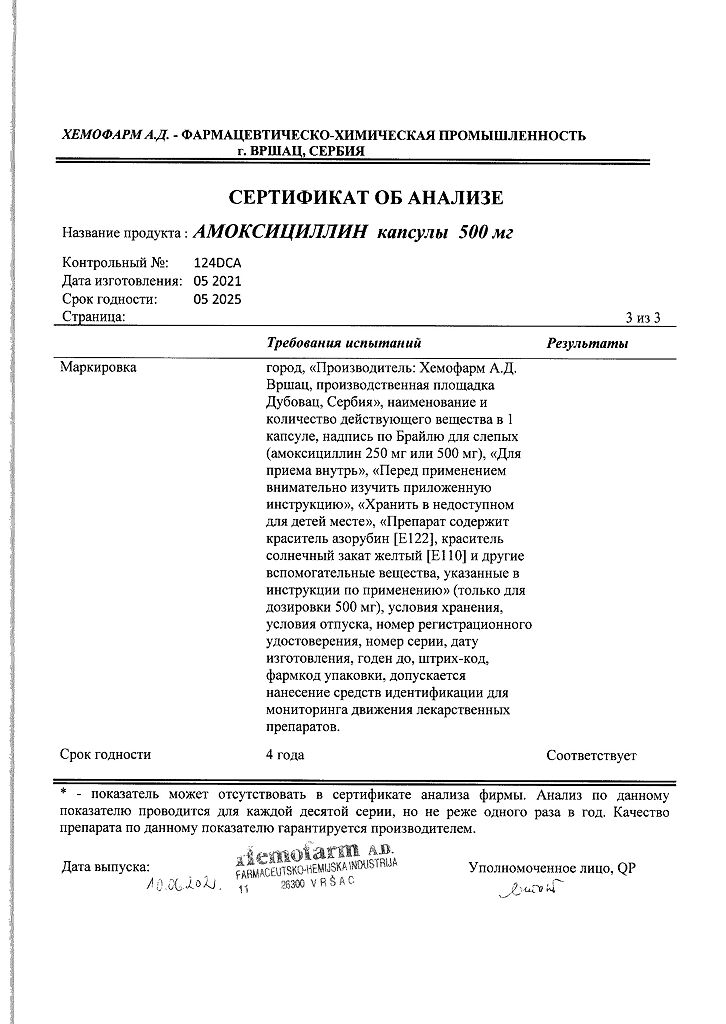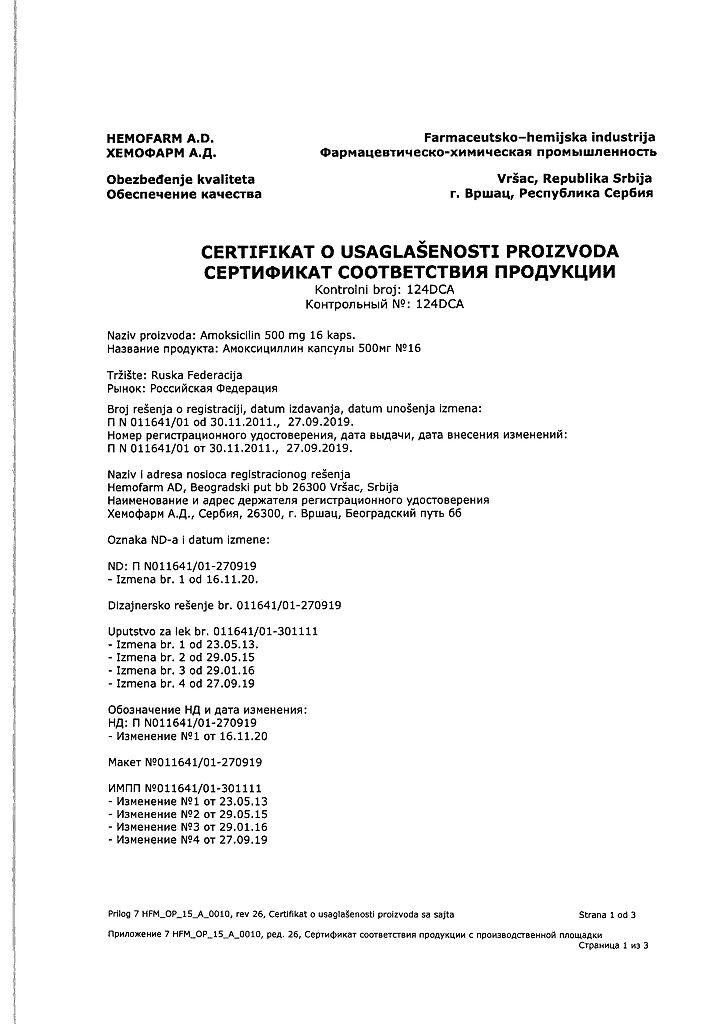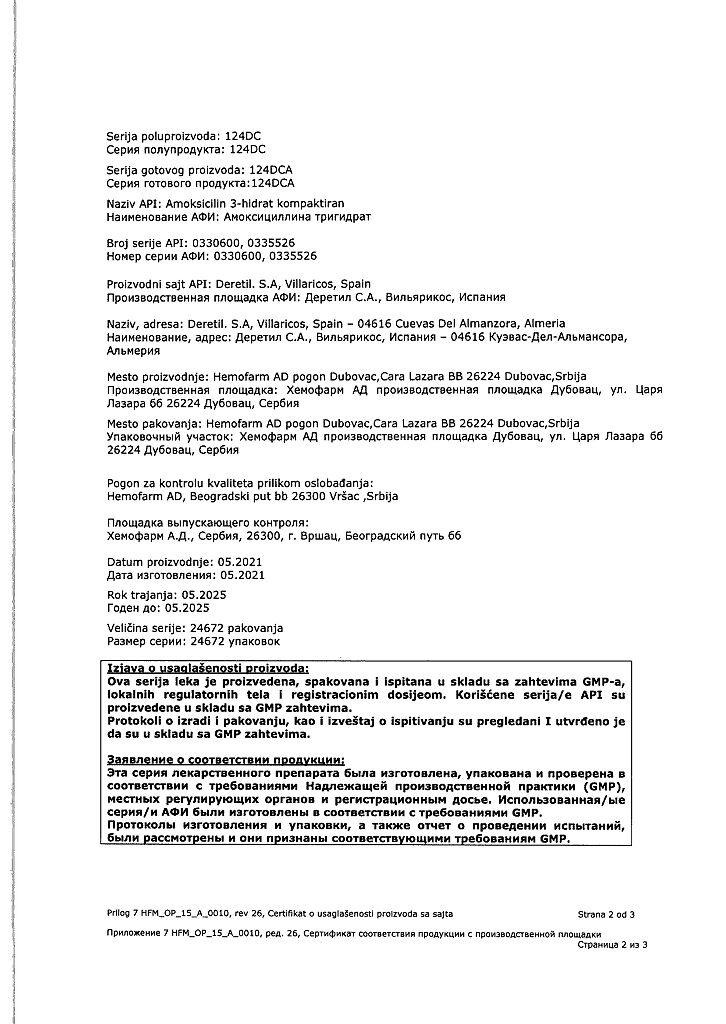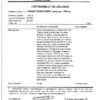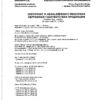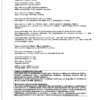No products in the cart.
Amoxicillin, 500 mg capsules 16 pcs
€3.31 €2.94
Out of stock
(E-mail when Stock is available)
Description
Pharmacotherapeutic group
Antibiotic, semi-synthetic penicillin
ATX code: J01CA04
Pharmacodynamics:
The semisynthetic aminopenicillin bactericidal acid-resistant broad-spectrum agent belongs to the group of beta-lactam antibiotics. It inhibits transpeptidase disrupts synthesis of peptidoglycan (support protein of cell wall) during division and growth causing lysis of bacteria.
Active against aerobic gram-positive bacteria: Bacillus anthracisCorynebacterium spp. EnterococcusfaecalisListeriamonocytogenesStaphylococcus spp. (except penicillinase-producing strains) Streptococcus spp.; including Streptococcuspneumoniae
Aerobic Gram-negative bacteria: BordetellapertussisBrucella spp. EscherichiacoliHaemophilusinfluenzaeKlebsiellaspp. NeisseriagonorrhoeaNeisseriameningitidesShigella spp. Salmonella spp. Pasteurellaseptica; Proteusmirabilis Vibriocholerae;
other microorganisms: Clostridium spp. Leptospira spp. and HelicobacterpyloriBorreliaburgdorferi.
Amoxicillin is degraded by beta-lactamases so its spectrum of antibacterial activity does not include microorganisms producing beta-lactamases (penicillinase, etc.).
Pharmacokinetics:
Absorption is fast high (about 93%) food intake has no effect on absorption; amoxicillin is not destroyed in the acidic environment of the stomach. Maximal concentration in plasma (Сmax) is reached after 1-2 hours (ТСmax) and is 35-5 µg/ml when administered orally in dose of 250 mg. The elimination half-life (T1/2) is 1-15 hours.
The binding to plasma proteins is about 17%. Intensively distributed in organs and tissues it is found in biological fluids and pathological secretions; it crosses histohematic barriers except for unchanged blood-brain barrier. In high concentrations found in blood plasma pulmonary bone and fat tissues intestinal mucosa female genital organs prostate gall bladder (with normal liver function) fetal tissues pleural and peritoneal fluid content of skin blisters sputum bronchial secretion (to a lesser extent in purulent discharges) in the exudate from middle ear inflammation.
The concentration in bile exceeds the concentration in blood plasma by 2-4 times. In amniotic fluid and umbilical cord vessels amoxicillin concentration is 25-30% of the value in the plasma of a pregnant woman. During inflammation of the brain membranes amoxicillin crosses the blood-brain barrier and its concentration in the cerebrospinal fluid reaches 20% of that in plasma. A small amount penetrates into breast milk. With increasing dose amoxicillin concentration in organs and tissues increases proportionally.
Partially metabolized to inactive penicillic acid. It is excreted mainly by the kidneys – 50-70% unchanged by tubular secretion (80%) and glomerular filtration (20%) through the intestine – 10 – 20%.
In case of impaired renal function (creatinine clearance less than or equal to 15 ml/min) the half-life is increased up to 85 hours.
Indications
Indications
Infectious and inflammatory diseases caused by microorganisms sensitive to amoxicillin:
Active ingredient
Active ingredient
Composition
Composition
1 capsule 500 mg contains:
the active ingredient:
amoxicillin 500.00 mg (in the form of amoxicillin trihydrate 573.9 mg);
excipients – magnesium stearate 9.20 mg, microcrystalline cellulose PH 102 – 26.90 mg; capsule â 0: gelatin to 96 mg; capsule cap: titanium dioxide [E 171] – 0.49920 mg, sunset yellow dye [E PO] – 0.13774 mg, azorubin dye [E 122] – 0.13336 mg; capsule body: titanium dioxide [E 171] -0.57600 mg, iron oxide yellow dye [E 172]-0.26899 mg.
How to take, the dosage
How to take, the dosage
Adults are prescribed 500 mg 3 times a day.
In severe course of the disease – 1 g 3 times/day.
In children aged 5-10 years old 250 mg 3 times a day, in children aged 2-5 years old – 125 mg 3 times a day, in children under 2 years old at the rate of 20 mg/kg of body weight (divided into 3 doses).
The course of treatment is 5-12 days. The interval between doses is 8 hours.
To treat acute uncomplicated gonorrhea, 3 g is prescribed once (in combination with 1 g probenecid).
In women, the above dose is recommended to be repeated after 24 hours.
Interaction
Interaction
Antacids, glucosamine, laxatives, aminoglycosides – slow down and reduce absorption of amoxicillin; ascorbic acid increases absorption.
Ethanol reduces the absorption rate of amoxicillin.
Amoxicillin promotes the absorption of digoxin.
Probenecid, competing for the excretion pathway, slows down the elimination of amoxicillin, which leads to increased plasma concentrations of amoxicillin. Similarly, amoxicillin interacts with diuretics, nonsteroidal anti-inflammatory drugs (oxyphenbutazone, phenylbutazone, acetylsalicylic acid, indomethacin).
Amoxicillin helps to reduce the clearance of methotrexate, which may lead to the development of toxic effects of the latter.
The simultaneous use of allopurinol increases the risk of skin allergic reactions.
Amoxicillin, by suppressing the intestinal microflora, helps to reduce the synthesis of vitamin K and prothrombin index, which increases the effectiveness of indirect anticoagulants and drugs that metabolize para-aminobenzoic acid, which ultimately increases the risk of bleeding “breakthrough”.
Amoxicillin reduces the effectiveness of oral contraceptives because estrogen reabsorption decreases under conditions of altered gut biocenosis.
When combining amoxicillin with bactericidal antibiotics (aminoglycosides, cephalosporins, cycloserine, vancomycin, rifampicin) synergistic antibacterial action is observed. Bacteriostatic drugs (macrolides, chloramphenicol, lincosamides, tetracyclines, sulfonamides), in contrast, weaken the bactericidal effect of amoxicillin.
Metronidazole increases the antibacterial activity of amoxicillin.
Special Instructions
Special Instructions
In patients with hypersensitivity to cephalosporins, carbapenems, the possibility of cross-allergy should be considered.
In severe gastrointestinal tract infections accompanied by persistent diarrhea or vomiting, amoxicillin should not be administered orally because of the possibility of poor absorption.
The use of antibiotics is ineffective in the treatment of acute respiratory viral infections.
Particular caution should be exercised in patients with allergic diathesis or bronchial asthma and hay fever (pollinosis), a history of GI diseases (especially colitis associated with antibiotic use).
In case of long-term use of Amoxicillin, nystatin, levorin or other antifungal drugs should be prescribed simultaneously.
When prolonged use of high doses of the drug in patients the parameters of liver and kidney function should be monitored, general urinalysis should be carried out. It is advisable to monitor the peripheral blood count.
Contraindications
Contraindications
Side effects
Side effects
Allergic reactions:
Hives, skin rash, erythema, exanthema, Quincke’s edema, rhinitis, conjunctivitis, photosensitization; rarely – fever, joint pain, eosinophilia; in single cases – anaphylactic shock.
Others:
Possible development of superinfection with the appearance of liquid stools, nausea.
Pregnancy use
Pregnancy use
There are currently no data on the possible embryotoxic, teratogenic or mutagenic effects of the drug when administered during pregnancy.
Amoxicillin is detected in breast milk, which should be taken into account when prescribing Amoxicillin during lactation.
Similarities
Similarities
Additional information
| Weight | 0.021 kg |
|---|---|
| Shelf life | 2 years. |
| Conditions of storage | Store in a dry, light-protected place at room temperature. |
| Manufacturer | Chemopharm A.D., Serbia |
| Medication form | capsules |
| Brand | Chemopharm A.D. |
Other forms…
Related products
Buy Amoxicillin, 500 mg capsules 16 pcs with delivery to USA, UK, Europe and over 120 other countries.

